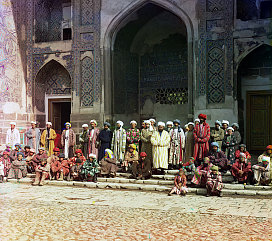S. M. Prokudin-Gorsky: The Splendors of Russia in Natural Color 1905–1916
Exhibition of Šechtl & Voseček Museum of Photography February–May 2006
Samarkand
 Samarkand is one of the oldest inhabited
cities in the world. Founded circa 700 B.C. Alexander the Great conquered it in 329 B.C. In 1370, Timur decided to make Samarkand the capital of his projected world empire. In 1868, the city came under Russian rule, when the citadel was stormed by a force under Colonel A.K. Abramov (1836-1886).
Samarkand is one of the oldest inhabited
cities in the world. Founded circa 700 B.C. Alexander the Great conquered it in 329 B.C. In 1370, Timur decided to make Samarkand the capital of his projected world empire. In 1868, the city came under Russian rule, when the citadel was stormed by a force under Colonel A.K. Abramov (1836-1886).
Samarkand

Вид с Тилля-Кари на Самарканд.
View of Samarkand from Tilla-Kari.
Library of Congress, Prints
and Photographs Division,
Prokudin-GorskiiCollection,
LC-DIG-prokc-21763. Digital color rendering by Jan Hubička based on color composite by Blaise Agüera y Arcas.
https://hdl.loc.gov/loc.pnp/prokc.21763

На Регистане.
On the Registan. Samarkand.
Library of Congress, Prints
and Photographs Division,
Prokudin-GorskiiCollection,
LC-DIG-prokc-21726. Digital color rendering by Jan Hubička based on color composite by Blaise Agüera y Arcas.
https://hdl.loc.gov/loc.pnp/prokc.21726

Часть минарета и купола Шир-Дор с Тилля-Кари.
A Portion of the Shir-Dar Minaret and its Dome from Tillia-Kari
Library of Congress, Prints
and Photographs Division,
Prokudin-GorskiiCollection,
LC-DIG-ppmsc-04440. Digital color rendering by Walter Frankhauser.
https://hdl.loc.gov/loc.pnp/ppmsc.04440


Группа еврейских мальчиков с учителем.
A group of Jewish boys with the teacher.
Library of Congress, Prints
and Photographs Division,
Prokudin-GorskiiCollection,
LC-DIG-ppmsc-04442. Digital color rendering by Walter Frankhauser.
https://hdl.loc.gov/loc.pnp/ppmsc.04442

Старик Сарт (бабайка).
A Sart old man (babaika).
Library of Congress, Prints
and Photographs Division,
Prokudin-GorskiiCollection,
LC-DIG-ppmsc-04441. Digital color rendering by Walter Frankhauser.
https://hdl.loc.gov/loc.pnp/ppmsc.04441

Сартянка.
Sart woman.
Library of Congress, Prints
and Photographs Division,
Prokudin-GorskiiCollection,
LC-DIG-ppmsc-03957. Digital color rendering by Walter Frankhauser.
https://hdl.loc.gov/loc.pnp/ppmsc.03957

Доктора.
Physicians. Samarkand.
Library of Congress, Prints
and Photographs Division,
Prokudin-GorskiiCollection,
LC-DIG-prokc-21771. Digital color rendering by Jan Hubička based on color composite by Blaise Agüera y Arcas.
https://hdl.loc.gov/loc.pnp/prokc.21771

Торговец лепешками.
Bread vendor, Samarkand.
Library of Congress, Prints
and Photographs Division,
Prokudin-GorskiiCollection,
LC-DIG-prokc-21765. Digital color rendering by Jan Hubička based on color composite by Blaise Agüera y Arcas.
https://hdl.loc.gov/loc.pnp/prokc.21765

Шашлычная.
Shashlik stand. Samarkand.
Library of Congress, Prints
and Photographs Division,
Prokudin-GorskiiCollection,
LC-DIG-prokc-21742. Digital color rendering by Jan Hubička based on color composite by Blaise Agüera y Arcas.
https://hdl.loc.gov/loc.pnp/prokc.21742

Водонос.
Water carrier. Samarkand.
Library of Congress, Prints
and Photographs Division,
Prokudin-GorskiiCollection,
LC-DIG-prokc-21730. Digital color rendering by Jan Hubička based on color composite by Blaise Agüera y Arcas.
https://hdl.loc.gov/loc.pnp/prokc.21730

Торговец материями.
Fabric merchant.
Library of Congress, Prints
and Photographs Division,
Prokudin-GorskiiCollection,
LC-DIG-ppmsc-03948. Digital color rendering by Walter Frankhauser.
https://hdl.loc.gov/loc.pnp/ppmsc.03948

Торговец дынями.
Melon merchant.
Library of Congress, Prints
and Photographs Division,
Prokudin-GorskiiCollection,
LC-DIG-ppmsc-03949. Digital color rendering by Walter Frankhauser.
https://hdl.loc.gov/loc.pnp/ppmsc.03949

Сартские поля.
Sart fields. Samarkand.
Library of Congress, Prints
and Photographs Division,
Prokudin-GorskiiCollection,
LC-DIG-ppmsc-04439. Digital color rendering by Walter Frankhauser.
https://hdl.loc.gov/loc.pnp/ppmsc.04439

Байга.
Bayga. Samarkand.
Library of Congress, Prints
and Photographs Division,
Prokudin-GorskiiCollection,
LC-DIG-ppmsc-04845. Digital color rendering by Walter Frankhauser.
https://hdl.loc.gov/loc.pnp/ppmsc.04845

Общий вид мечети Шах-Зинде. (вечерний снимок).
General view of Shah-e-Zindeh (at sunset).
Library of Congress, Prints
and Photographs Division,
Prokudin-GorskiiCollection,
LC-DIG-ppmsc-03978. Digital color rendering by Walter Frankhauser.
https://hdl.loc.gov/loc.pnp/ppmsc.03978

Главный вход в мечеть [ошибка в авторском описании, на самом деле некрополь ] Шах-Зинде.
The main entrance to Shah-e-Zindeh. Samarkand.
Library of Congress, Prints
and Photographs Division,
Prokudin-GorskiiCollection,
LC-DIG-prokc-21817. Digital color rendering by Jan Hubička based on color composite by Blaise Agüera y Arcas.
https://hdl.loc.gov/loc.pnp/prokc.21817

Часовня на горе Чапан-Ата в 5 верст. от Самарканда.
Chapel on Chapan-Ata Mountain, five versts from Samarkand.
Library of Congress, Prints
and Photographs Division,
Prokudin-GorskiiCollection,
LC-DIG-prokc-21894. Digital color rendering by Jan Hubička based on color composite by Blaise Agüera y Arcas.
https://hdl.loc.gov/loc.pnp/prokc.21894